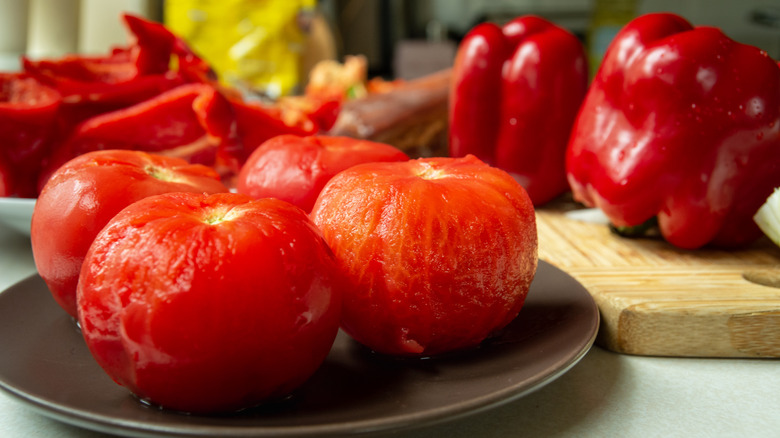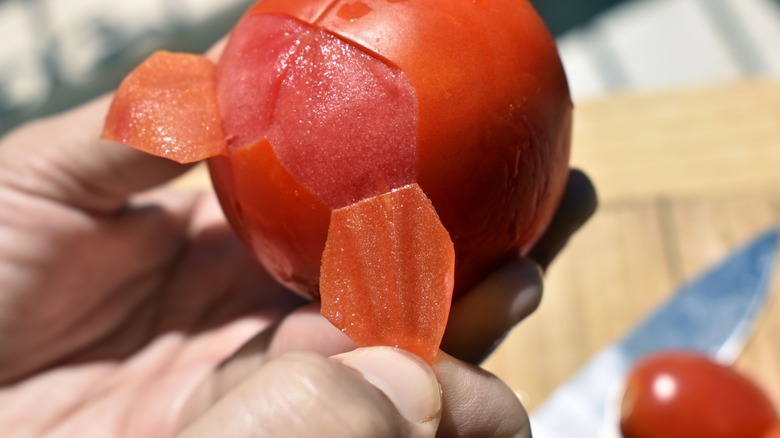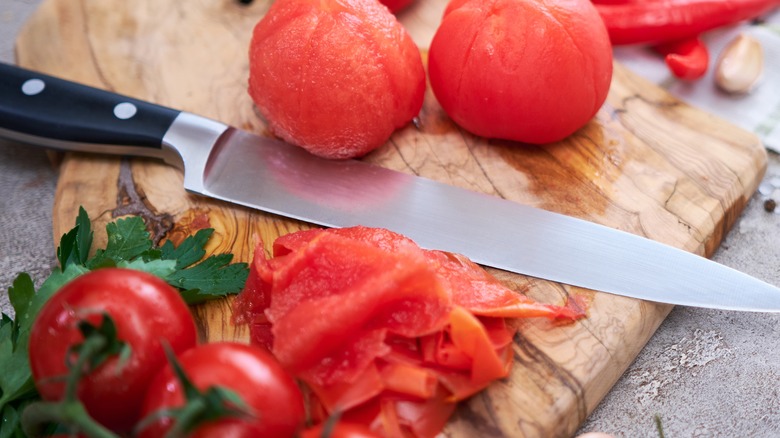How To Peel Tomatoes (And Why You Should)
Before you whip up a bowl of delicious fresh tomato sauce or soup, you first need to embark on the not-so-fun process of peeling the tomatoes. There are a few methods for how to do this, from freezing the tomatoes (this can take too long, though) to the microwaving method (which can be a bit erratic — plus it poses the risk of your tomatoes exploding in the microwave). That leaves us with the blanching technique, which takes a short time and is easy to do.
First, set a pot of water on the stovetop to boil and prepare a separate bowl of cold water with ice cubes. As the pot of water is heating, wash your tomatoes thoroughly and remove the stems. Cut an "X" mark on the bottom end of the tomatoes using a paring knife. Don't make it too deep — just slice through the skin. Next, put the tomatoes in the boiling water and blanch them for between 30 and 60 seconds.
Once the timer goes off, turn off the stove, grab a spider strainer or slotted spoon, and use it to transfer the tomatoes into the ice bath. This process not only makes the red orbs safe for handling, but it also halts the cooking process. Leave them in the bath for about five minutes or until you notice the peels looking shriveled. Then, remove them from the water bath and start pulling back the skin bit-by-bit starting from the "X" mark.
To peel or not to peel tomatoes
It's easy to find yourself peeling tomatoes just out of a habit, but is it really necessary? Well, if the dish you're preparing requires a smooth texture, like tomato sauce, jam, or soup, then using skinless tomatoes is the best option. This is because the skin usually turns tough as it cooks and that will create a rough texture in the finished dish. Tomato peels also become bitter as they cook, which will interfere with the sweet flavor you're expecting. So for a sweet, mellow flavor and a smooth texture, go ahead and peel your tomatoes first.
However, there are instances where peeled tomatoes aren't ideal. For example, if you're making a sandwich, the sliced tomato is better left intact, as the skin helps keep the veggie together. Furthermore, there are nutritional benefits of leaving the tomato peel in situ. The peels contain a key antioxidant called flavonol, which helps reduce the risk of heart disease and high blood pressure. So if you're keen on acquiring these nutrients, you may want to keep the tomato peels. Alternatively, you can peel the tomatoes and store the skins for later use.
How to use tomato peels
If you have to peel your tomatoes before cooking but don't want to miss out on all the nutrients in the skin, there's a solution. Simply store the tomato skins for use in other food preparations. For example, you can freeze the peels and use them later to make stock. To do this, boil the peels with other vegetable scraps, like onion pieces, carrot bits, and herbs, until you form a flavorful liquid. Next, sieve out the solids and use the liquid as a delicious base a unique twist on a basic tomato soup.
Another way to use up the tomato skins is to turn them into a topping to level up your salads and soups. First, fry the skins in a little oil until they're completely crispy and crunchy. You can also snack on these tomato chips as is. Yum.
Tomato peels can also be dried low-and-slow in an oven until they're completely dehydrated. Then, they can be crushed and ground into a fine powder. Use the powder to sprinkle on any meal to infuse it with the tomato's subtle sweet and tangy flavors.


